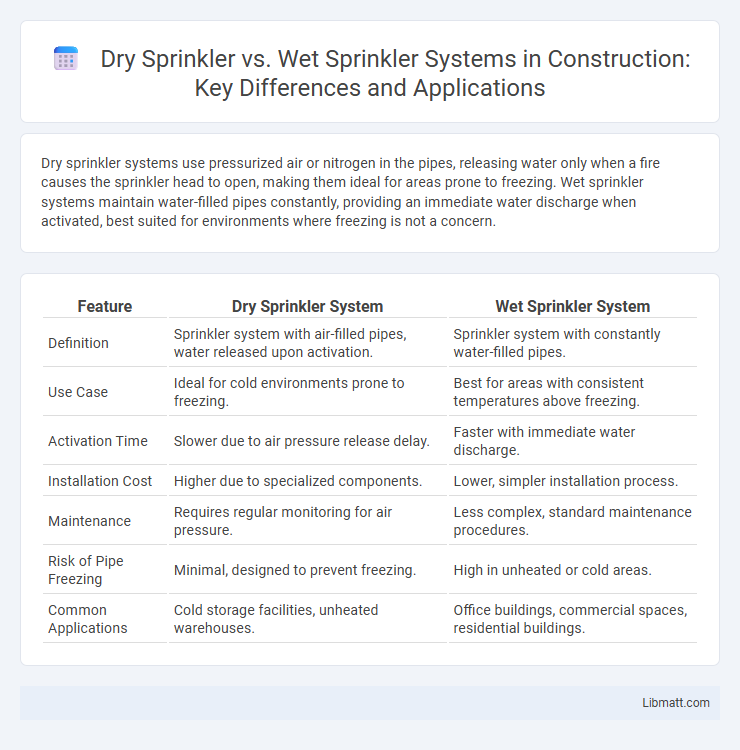Dry sprinkler systems use pressurized air or nitrogen in the pipes, releasing water only when a fire causes the sprinkler head to open, making them ideal for areas prone to freezing. Wet sprinkler systems maintain water-filled pipes constantly, providing an immediate water discharge when activated, best suited for environments where freezing is not a concern.
Table of Comparison
| Feature | Dry Sprinkler System | Wet Sprinkler System |
|---|---|---|
| Definition | Sprinkler system with air-filled pipes, water released upon activation. | Sprinkler system with constantly water-filled pipes. |
| Use Case | Ideal for cold environments prone to freezing. | Best for areas with consistent temperatures above freezing. |
| Activation Time | Slower due to air pressure release delay. | Faster with immediate water discharge. |
| Installation Cost | Higher due to specialized components. | Lower, simpler installation process. |
| Maintenance | Requires regular monitoring for air pressure. | Less complex, standard maintenance procedures. |
| Risk of Pipe Freezing | Minimal, designed to prevent freezing. | High in unheated or cold areas. |
| Common Applications | Cold storage facilities, unheated warehouses. | Office buildings, commercial spaces, residential buildings. |
Introduction to Fire Sprinkler Systems
Fire sprinkler systems play a crucial role in fire safety, designed to automatically detect and suppress fires. Wet sprinkler systems contain water in pipes at all times, ideal for environments where freezing is not a concern, while dry sprinkler systems use pressurized air or nitrogen and release water only when activated, suitable for cold or unheated spaces. Understanding the differences helps tailor your fire protection strategy to the specific needs of your building environment.
What is a Wet Sprinkler System?
A wet sprinkler system is a fire protection system where the sprinkler pipes are continuously filled with water, allowing immediate discharge when a sprinkler head is activated by heat. This system is ideal for indoor areas with temperatures above freezing, ensuring rapid fire suppression. Your choice of a wet sprinkler system enhances safety by providing swift water delivery to control or extinguish fires effectively.
How Does a Dry Sprinkler System Work?
A dry sprinkler system operates by maintaining pressurized air or nitrogen inside its pipes, preventing water from entering until activation. When a fire triggers the sprinkler head, the air pressure drops, causing a valve to open and allowing water to flow through the pipes to extinguish the fire. This system is ideal for environments susceptible to freezing temperatures, as it prevents water from freezing inside the pipes.
Key Differences Between Wet and Dry Sprinkler Systems
Wet sprinkler systems contain water in the pipes at all times, allowing for immediate fire suppression upon activation, making them ideal for heated environments. Dry sprinkler systems use pressurized air or nitrogen to keep water out of the pipes until a fire triggers the system, preventing freezing in unheated or cold areas. Understanding these key differences helps ensure your fire protection system is suited to your specific environmental conditions and safety needs.
Applications and Ideal Uses for Wet Sprinkler Systems
Wet sprinkler systems are ideal for environments where the temperature remains above freezing, such as office buildings, schools, and warehouses, ensuring immediate water discharge upon activation. These systems are commonly applied in spaces with consistent climate control to prevent pipe freezing and maintain reliable fire suppression. Your choice of a wet sprinkler system enhances safety in areas with uninterrupted heating, avoiding potential water damage caused by frozen pipes common in cold environments.
Best Scenarios for Dry Sprinkler Installation
Dry sprinkler systems are ideal for environments prone to freezing temperatures, such as unheated warehouses, parking garages, and exterior canopies, where water-filled pipes risk freezing and bursting. These systems use pressurized air or nitrogen to keep water back until a sprinkler head activates, preventing pipe damage in cold conditions. Their design ensures reliable fire protection in areas exposed to moisture and cold, making them essential for buildings without climate control.
Advantages of Dry Sprinkler Systems
Dry sprinkler systems offer significant advantages in environments prone to freezing temperatures by preventing water from residing in pipes and reducing the risk of pipe bursts. These systems activate by allowing pressurized air to escape, triggering water flow only when a sprinkler head is heat-activated, thus ensuring reliable operation in cold or unheated areas. Their design enhances safety and protects property in warehouses, parking garages, and unheated buildings where wet sprinkler systems would be vulnerable to freezing damage.
Benefits of Wet Sprinkler Systems
Wet sprinkler systems provide immediate water discharge upon activation, reducing response time in fire suppression. Their simpler design minimizes maintenance requirements and decreases the risk of system damage caused by freezing or corrosion. These systems are ideal for environments where constant temperature control prevents pipe freezing, ensuring reliability and effective fire protection.
Cost and Maintenance Comparison
Dry sprinkler systems typically incur higher installation costs due to specialized components like air compressors and insulation required for freeze protection, whereas wet sprinkler systems are generally more cost-effective to install in non-freezing environments. Maintenance expenses for dry systems can be greater because they require regular air pressure checks, valve inspections, and freeze prevention measures, while wet systems demand less frequent upkeep, primarily involving visual inspections and water flow tests. Overall, the total cost of ownership for dry sprinkler systems tends to be higher, driven by more complex maintenance and system components tailored for cold climate applications.
Choosing the Right Sprinkler System for Your Building
Selecting the appropriate sprinkler system depends on the building's environment and risk factors; wet sprinkler systems are ideal for heated buildings due to their continuous water presence, ensuring immediate fire suppression. Dry sprinkler systems are suitable for unheated or cold areas where pipes are prone to freezing, using pressurized air to hold water back until activation. Consider climate, building use, and maintenance requirements to ensure optimal fire protection and system longevity.
Dry sprinkler vs Wet sprinkler system Infographic

 libmatt.com
libmatt.com